Abstract
Environmental sustainability is a fundamental asset in the development of all agricultural policies within the European Union. However, its practical application is finding important incompatibilities between several of its objectives, such as the preservation of the landscape and action against climate change, through the exploitation of renewable energies systems. Indeed, Spain and its viticulture under PDOs are facing an exponential dilemma: the change in use of agricultural wine grape producing land to install solar panels for renewable energy generation. Therefore, this study aims to provide an assessment of the community where the Alicante PDO is based, on the environmental sustainability of its vineyards in view of the implementation of photovoltaic solar energy plants, and to identify an optimal and socially sustainable design. Online research techniques ensuring anonymity were used, achieving a valuation of the quality of the wine-growing landscape and its associated cultural heritage in the territory of the of Alicante PDO. However, as the importance of solar energy generation is also valued, the preferred alternative would be a limited combination of use and design to maintain the wine-growing landscape. These terms should be reflected by competent administrations when authorizing future installations in the Alicante PDO.
1. Introduction
Climate change is a reality that is affecting the global environment, altering the economies of countries, and influencing the existence of their citizens. Consequently, viticulture, a centuries-old cultivation system that has significantly influenced the development of landscapes of particular value, the culture and lifestyle of its populations and territories, thus shaping the identity and cultural heritage of wine-growing regions, is not exempt from the new challenges posed by climate change. Recently, the modernization of vineyard cultivation, due to an increasing demand for quality wines and the rise of wine tourism, has generated a new agrarian landscape, which is institutionally and socially recognized [1], which justifies the interest in environmental sustainability around wine [2].
The relationship between humans and nature materializes landscapes [3]. This is why, within the context of climate change and, given the difficulty of harmonizing development, conservation in fragile environments, and reconciling nature conservation with socioeconomic development [4], correct political decision-making around landscape planning and management is necessary, considering the interests of all parties involved [5].
‘Heritage’, ‘landscape’, and ‘participation’ concepts are articulated by experts in legal and policy documents, highlighted in particular in the World Heritage Convention and the European Landscape Convention [6]. However, in the absence of recommendations from governments, due to their inability to coordinate departments, private initiatives in the wine sector have recovered the landscape. They have reinforced the identity of their wines [1] in order to protect the landscape value of the vineyards in Protected Designations of Origin (PDOs) against abandonment and deterioration [7] and to adapt them to new contexts of innovation and rural development [8]. The landscape has been incorporated into its business strategy as an enhancer of wine tourism and rural development, thus integrating the territory into wine. Therefore, in this expansive context, the landscape begins to be used as an economic lever and a territorial resource [9]. These are protection strategies that have also been developed in regions registered as cultural landscapes categorized as UNESCO World Heritage Sites. For example, in similar subject regions of this study, “Tokaj” is the only landscape in Hungary legally recognized as historically linked to the homonymous wine [10].
Consequently, wine-growing landscapes have been gaining importance worldwide, which, together with the demand and production of quality wine together and the rise of wine tourism, has positioned them as a great innovation for the revitalization of agricultural spaces [11]. For example, they have enhanced areas in clear decline, helping them to increase agricultural income and, in some cases, established a new population or maintained an existing one [12].
In contrast, various studies have shown that market forces influence landscape change to a much greater degree than implemented policy measures. Thus, the evolution of international tourism and quality wine markets have played a fundamental role in the change in land use and the intensity of agriculture, where the integration of landscape maintenance practices, together with the commitment to quality wine, can be synergistically beneficial [13].
Understanding the implications that the different visions and power relations between experts and non-experts have for the development of participatory heritage conservation and management policies within cultural landscapes is essential to deal with the different articulations of heritage values that they make, their meaning, their preservation, and to resolve conflicts that may have been generated [14]. A clear example is the following dilemma which has arisen regarding environmental sustainability and that viticulture in PDOs have been facing in Spain for a short, but exponentially increasing, time: the change in the use of agricultural land that currently produces wine grapes to install solar panels that generate renewable energy.
World renewable energy production has experienced a 5% increase in the last year of up to 7,857,803 GWh, meaning photovoltaic solar a 13%. In Europe, Spain contributes a tenth of this production, and is ranked as the second European country in solar production (27,098 GWh) and fourth in photovoltaics (18,214 GWh) [15].
The generation of electrical energy through photovoltaic solar panels has become one of the most popular renewable energy sources to mitigate climate change and achieve global neutrality in CO2 emissions. Indeed, 0 kg of CO2 per 1 kWh is emitted into the atmosphere, while 0.568 kg CO2 is reduced [16], summing other benefits such as decreasing the use of fossil fuels and succeeding at energy self-sufficiency.
The solar energy potentials find no limits, and further implementations show relevancy in the climate change context [17]. However, this implies a shift towards intensive land use to generate solar energy to the detriment of existing agricultural coverage, which is causing a multitude of social conflicts [18].
The dilemma that we are going to analyze is the case of the Alicante PDO, which dates back to 1510 and is located in the southeast of Spain, occupying some 15,000 hectares of vineyards. Alicante, with an annual sunshine duration of more than 2700 h, is placed in climatic area V (Figure 1), which ensures an average daily annual global solar radiation of over 5.0 kWh/sqm, consequently meaning an annual solar radiation of over 1826 kWh/sqm [19,20,21]. Consequently, Alicante has favorable conditions for the conversion of solar energy into electricity.
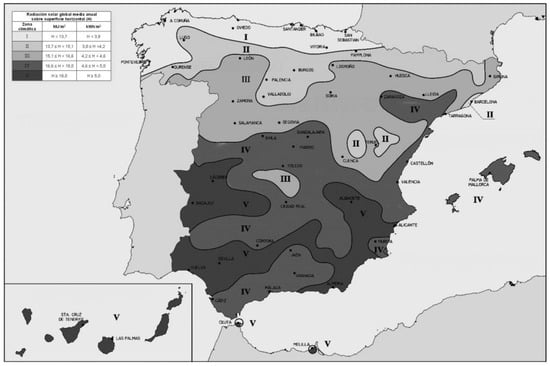
Figure 1.
Solar radiation climatic areas in Spain (CTE).
In this region, the sun, a tourist resource and a great promoter of the ancestral wine culture in Alicante, its increased prestige and its sustainable wine tourism, is postulated paradoxically as territory degrader in areas where rainfed crops such as vines predominate and whose returns are more subject to uncertainty. This fact, together with the lack of generational change, encourages winegrowers to consider selling or renting their vineyards to photovoltaic energy companies, which assures them a fixed annual income (from €1300/hectare to €2300/hectare depending on the aptitude land for power generation) without effort, thus constituting a very attractive alternative.
In addition, state and regional public administrations in Spain, protected by law [22], have adopted various measures since 2020 to accelerate the implementation of facilities for the use of renewable energies due to the climate emergency and the need for urgent economic reactivation, in compliance with the National Integrated Energy and Climate Plan (PNIEC) 2030 guidelines [23].
Subsequently, a large number of projects have been presented (regional approval if less than 50 MW and a state approval requirement if more than 50 MW) to achieve that goal in the very short term, which has provoked protests from environmental groups, neighborhoods, and agrarian associations [24]. It must be considered that the majority of companies requesting photovoltaic solar projects tend to operate under the financial umbrella of investment funds, many of them foreign, which take advantage of the inertia of energy reconversion without caring about the local frictions that these types of projects generate in the aforementioned groups and the councils of the affected municipalities.
However, the dilemma is also presented to these associations and groups since they are not against the development and promotion of renewable energies. But experiencing what they call “manifest energy speculation”, they propose an alternative model of small plants (no more than 5–10 MW) with the generated energy being distributed through energy communities located near urban centers for self-consumption, avoiding long high-voltage lines that intensify environmental impacts and also put their agricultural heritage at risk.
Faced with this threat, the Alicante PDO has carried out various mobilization strategies [25], publishing the institutional manifesto “The Vineyard of the Sun” [26] and collecting signatures to protect its wine-producing territory against the progressive proliferation of solar plant projects. As a result, the regional government has processed the Catalogue for the Protection of Agricultural Cultural Landscapes of Wine [27,28].
The competition for land derived from the transition to renewable energies is scientifically proven (a minimum of 2 hectares is necessary for each installed MW), and economically reasoned [29]. Solar energy generation seems to have become one of the most popular sources to achieve global carbon neutrality [18]. The expected production of solar energy in Spain would require approximately 0.65% of the national territory, estimating up to 22 million tons of emissions due to the change in land use [30]. Therefore, the regulation, planning, and implementation of the system must be conscientious in order to avoid a significant increase in its life cycle emissions through terrestrial carbon losses [31]. In addition, it is possible that the installation of photovoltaic plants on arable land irreversibly damages the soil [32]. Various studies consider that the development of these photovoltaic plant systems should only be implemented in degraded areas, less viable for agricultural use [33], and should also be addressed locally from an intersectoral perspective [34].
Consequently, many municipalities where Alicante PDO vineyards are located have declared a moratorium on the licenses to build these photovoltaic installations to avoid the uncontrolled avalanche of projects. This is due to the absence of land use planning that should consider these projects since the rapidity of their technological and economic evolution has not allowed territorial plans to be updated. Local governments are very concerned that a point of difficult return has been reached, destroying landscapes and crops, and causing even more, if possible, emptying of the population of agricultural municipalities at risk of depopulation.
It is for all the exposed arguments that, given the proliferation of these colloquially called “solar farms” as a sustainable action against climate change, we consider it interesting to know what the opinion of the society where the Alicante PDO is located is on this dilemma of sustainability in the vineyard, as no previous survey has been carried out. Positions range from strong landscape protection to total freedom for installation, with an intermediate situation of pragmatic integration through the application of new “agrivoltaic” technologies that imply the symbiotic coexistence of vineyards and solar panels on the same plot, allowing agricultural production and energy production to occur simultaneously. The integration of both productions in the same area, a concept originally born in 1982 [35], enables the increase in the land use efficiency and the total revenue in the agricultural sector [36,37,38,39], land productivity increased by 70% [40], although this integration may reduce the efficiency of either one or both productions [41].
These “agrivoltaic” alternatives make it possible to combine the maintenance of agricultural land and its landscape, increasing its productivity with the generation of electricity as green energy, and therefore enhancing local economic development, as well as the fight against climate change with the production of emission-free renewable energy. Intelligent shading “agrivoltaic techniques”, which may regulate sun incidence and the temperature on the vines, favor the use of the same land to obtain solar energy and viticulture products [42], and could be of interest to achieve a progressive ripening of the grapes in order to ensure acidity and aromas in the wine and to save on electricity consumption and irrigation in the vineyards partially shaded with solar panels, while generating renewable energy. Consequently, the expansion of “agrivoltaic” models would therefore entail an alternative in the search for that balance between the need for renewable energy and territory conservancy and cultivation and could also significantly contribute to stop global warming and ensure food supply [43].
Accordingly, the objective of this research is to know the assessment of the society where the Alicante PDO is based on the environmental sustainability of its vineyards in view of the implementation of photovoltaic solar energy plants, in order to know which model would be socially accepted, and if the shift to “agrivoltaism” is socially sustained. No general opinion poll has been carried out to the population so far.
To this end, the following six sub-objectives are proposed: firstly, to assess the quality of the existing wine-producing landscape and its cultural heritage compared to the quality of a photovoltaic landscape; secondly, to know the opinion on what use the wine-producing territory of Alicante PDO should have; thirdly, to identify the opinion on photovoltaic panel installations and what limitations should be placed on their facilities for sustainable social acceptance; fourthly, to know the opinion regarding the design of photovoltaic panel installations in the event that the competent authority allows them; fifthly, to analyze the significant perception differences among population and if they are influenced by their social profiles; and sixthly, to identify the main factors that underlie the survey and stir up surveyed preferences.
2. Materials and Methods
The studied population was the province of Alicante, an administrative entity in Spain where Alicante PDO vineyards are located with an area of 5816 km2.
In order to gather the necessary information to achieve the four first objectives, minimizing costs and maximizing scope, a questionnaire was designed using Google Forms and “snowball sampling” online research techniques. Questionnaire diffusion was through electronic and social networks. A modality that is included within the surveys by self-administered questionnaires [44] ensures anonymity at all times and opens for reply for a period of one month in December 2022.
Based on previous public social surveys carried out in the province related to the matter, the form contains two types of questions, some with a 5-point Likert scale response and others with a single choice among several options. The questionnaire has been structured in the following 5 sections:
- -
- The first section with responses on a 5-point Likert scale, seeks to know the assessment that respondents make of the wine-growing landscape and wine-growing cultural heritage framed in the Alicante PDO and the landscape offered by photovoltaic plant installations (Table 1).
 Table 1. Valuation of wine-producing territory Alicante PDO (Likert scale 1 to 5).
Table 1. Valuation of wine-producing territory Alicante PDO (Likert scale 1 to 5). - -
- The second section, through a single choice among several options, consults the preference for land use and the setting, or not, of limitations in the case of photovoltaic installations.
Hence, firstly asked for is the surveyed opinion regarding the use of the land (Table 2). It asks if they prefer to maintain the vegetation cover with the vines to produce wine (Figure 2), if they rather prefer the land be dedicated solely to the installation of solar panels for renewable energy production (Figure 3), or if they opt for the combination of both uses in the same plot, “agrivoltaic” production (Figure 4).

Table 2.
Opinion on the use of wine-producing territory in the Alicante PDO.

Figure 2.
Vineyards in Alicante.
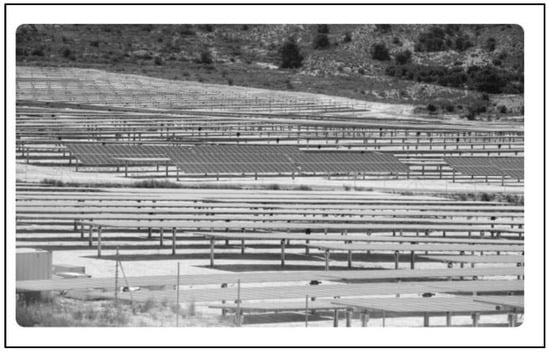
Figure 3.
Solar panels installation in Alicante.
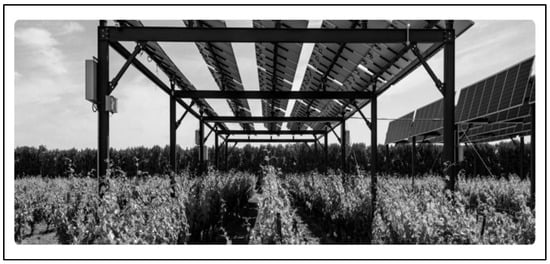
Figure 4.
“Agrivoltaic” production in Ribera del Duero.
Then, they are asked which of the offered options is perceived as more respectful to the environment (Table 2).
- -
- The third section consults what opinion do those surveyed have regarding the installation of solar panels in vineyards located in producing areas of the Alicante PDO (Table 3) in terms of prohibiting their installation, allowing it without limitations, or allowing it with certain limitations. The “Does not know/does not answer” option is contemplated in all cases.
 Table 3. Opinion on photovoltaic panels installations in Alicante PDO.
Table 3. Opinion on photovoltaic panels installations in Alicante PDO.
For those respondents who would establish limitations to photovoltaic installations, access was given to another round of questions to find out, through 5-point Likert scale responses, if those limitations would be in terms of total occupied area, site design of panels, perimeter fencing, visual protection through trees and shrubs, earth movement required to settle the installation, or style of the necessary buildings for facility maintenance and operation (Table 3).
- -
- The fourth section, through a single choice among several options that also considers “does not know/does not answer”, focuses on finding out preferences regarding the design characteristics that a solar panel installation should meet to be accepted (Table 4). Following the structure of the previous section, the preferred attributes for each limitation are investigated.
 Table 4. Opinion on design of photovoltaic panel installations in Alicante PDO.
Table 4. Opinion on design of photovoltaic panel installations in Alicante PDO.
So, in the event that the competent authority authorizes a photovoltaic installation, those surveyed were asked about their preference in terms of the total area the facility should occupy. A size equivalent to a soccer or golf field is indicated for the different options so the respondents may have a reference of the magnitude involved.
In relation to solar panel distribution and their installation, respondents can select between a continuous and compact design or a dispersed design of panel islands with environmental corridors or vineyards among them.
They were also asked about their preference in the location of the energy transmission lines, aerial or underground, and also about the type of perimeter fencing of the photovoltaic installation, being able to choose between the absence of it, or within different options such as simple torsion, cynegetic, natural structures of wood or cane, and natural perimeter protection by trees or shrubs (Figure 5, Figure 6, Figure 7 and Figure 8). For this last option, they were also asked if they would prefer hedges, plantations, or the formation of groves with local species from the area.

Figure 5.
Simple torsion fencing.

Figure 6.
Cynegetic fencing.
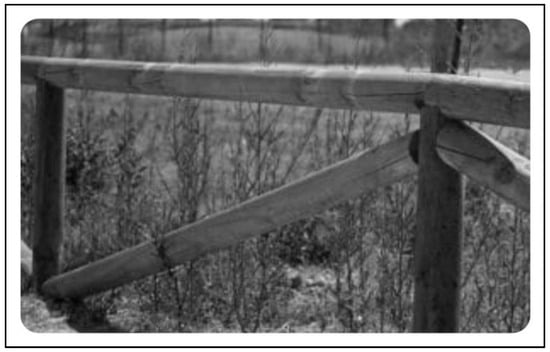
Figure 7.
Wooden fencing.
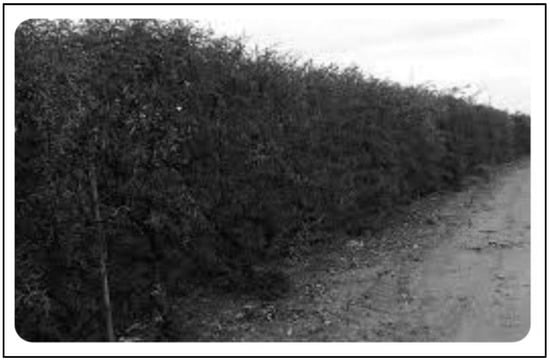
Figure 8.
Fencing with trees or shrubs.
With regard to the necessary earth movement to undertake solar panel installation two models were asked to consider: first, a model that modified as much of the soil structure as it needed to level the ground and maximize the efficiency of the solar panels, and second, on the contrary a smaller movement to respect the original orography of the land as much as possible, adapting the location of the solar panels to the original profiles.
And finally, the style of the buildings that are needed for equipment keeping, being able to choose among basic constructions without a special finish, or others whose design and materials are more consonant with the environment were considered.
- -
- The last section involves the socioeconomic data of the sample, including age, gender, educational level, occupation, income level, place of residence, and role within the wine sector. The choice was given between different values and ranges, with the option not to answer.
For the sample size calculation, the following formula was used [45]:
n = (N × Z2 × p × q)/((N−1) × c2 + Z2 × p × q)
The population studied was the province of Alicante whose census in 2021 was 1,901,594 inhabitants. The first target was set with a 5% margin of error, a confidence level of 95%, and heterogeneity of 50%, with n = 385 people. But ultimately only 122 enquiries were collected, which meant a 9% margin of error with a confidence level of 95% and p = q = 0.5. This number of collected surveys is a consequence of the chosen method to obtain the questionnaire. Cronbach’s alpha coefficient to measure research reliability is 0.723, which can be considered acceptable according to Nunally and Bernstein [46], being within 0.7 and 0.95.
To achieve the fifth objective, analyzing perception differences and possible influences, a segmentation of the sample is needed. So, considering the average replies to the items of the last section of the form (gender, age, educational level and relationship with wine sector), the surveyed are divided into groups per item in order to find significant differences (p < 0.05) using the Chi-squared index for qualitative variables, and the Mann–Whitney U test (2 groups) or Kruskal–Wallis (3 groups) test for the 5-point-Likert scale items, with the free software “R program” [47].
Lastly, to identify the main factors that underlie the survey, an exploratory factorial analysis is convenient. This multivariable analysis technique allows the reduction in the excess of information associated with multivariable collection to the main representative components. These latent components or factors represent the group of questions that explain relations among them without lack of information [48]. Principal component analysis and Kaiser’s varimax normalization were the extraction and rotation methods used, respectively.
3. Results
3.1. Demographic Statistics
Several studies show that the response rate of online studies depends on personalized contact strategies [49]; on the individual interests in the addressed subject; on the length of the survey; and some other technical factors [50]. As a matter of fact, this modality of survey circulation presents certain limitation in the adequacy of the sample to the structure of the population studied. Thus, in age distribution (Table 5), adult-age (61.5% of the sample compared to 31.5% of the population) and young people (24.8% of the sample compared to 22.2% of the population) have benefited compared to the senior age group (11.2% of the sample compared to 22.2% of population). Moreover, with regard to educational level, university has predominated (81.1%) (Table 5). Without undermining the external validity of virtual research [51], the used technique has been an efficient tool to maximize the time–cost relationship, although it has been observed that “snowball sampling” entails an initial conditionality motivated by the initial core [52].

Table 5.
Demographic data of the sample.
The previous demographic data have served as a basis for carrying out the first three segmentations that analyze the influence of certain characteristics of the population on the responses. The first segmentation is by gender and involves generating two groups: female and male. The second segmentation is by age and divides the population into three groups: young (18–35 years), adult (36–65 years) and senior (>65 years). The third segmentation is by educational level and concerns two groups: university students and non-university students (Primary School, Secondary/Medium Grade Professional Education and Bachelor/Higher Grade Professional Education). The fourth planned segmentation divides the population based on its relationship with the wine sector into two groups: those who do have a relationship with the wine sector (Winegrower/Vineyard owner, Cellar-keeper/Winemaker/Wine distributor and Wine consumer/Wine tourist) and those who do not (Table 6). It should be noted that 47% of those surveyed stated that they were not related to the wine sector, 44% considered themselves consumers or wine tourists, only 7% were related to wine industry as winemakers, oenologists or distributors, and only 2% were winegrowers. Consequently, we have segmented the sample into two groups: those who do have a relationship with the wine sector (Winegrower/Vineyard owner, Cellar-keeper/Winemaker/Wine distributor and Wine consumer/Wine tourist) and those who do not.

Table 6.
Relationship of the sample with the wine sector.
3.2. Descriptive Statistical Analysis
Below are the descriptive statistics results obtained from the questions raised in the different sections of the questionnaire regarding sustainability in the vineyards in the Alicante PDO versus the implementation of photovoltaic solar power plants.
3.2.1. Landscape Quality
Regarding landscape quality, respondents value the wine-producing landscape of the Alicante PDO territory and its concomitant cultural heritage more positively (3.81 and 3.96) than landscape quality related to photovoltaic panel installations (2.51) (Figure 9).
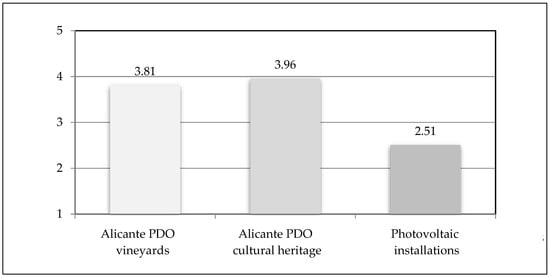
Figure 9.
Valuation of the wine-producing territory, Alicante PDO (Likert scale 1 to 5).
3.2.2. Land Use
The preferred option of land use is the combination of vineyards with photovoltaic panel installations, chosen by 64.8% of those surveyed, and also being considered the most environmentally friendly option by 54.1%. The second choice is maintaining vineyards only with 32.8%, which is considered by 44.3% of the respondents as more respectful to the environment. Finally, the less attractive option is the solo use of photovoltaic panels, since only 1.6% consider it to be the best option for land use, and even less (0.8%) consider it to be the most respectful to the environment (Figure 10).
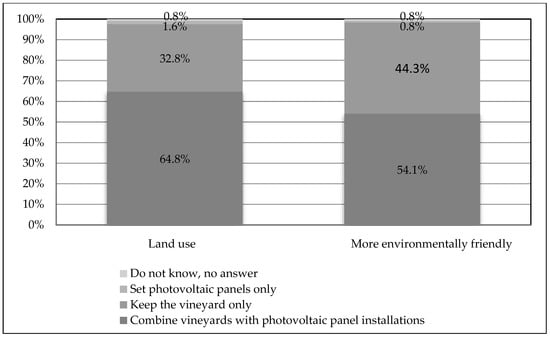
Figure 10.
Opinion on the use of wine-producing territory in Alicante PDO.
3.2.3. Opinion on Photovoltaic Installations in Alicante PDO
A vast majority of the respondents (68.9%) are in favor of allowing the installation of photovoltaic panels, but with certain limitations. However, almost a third (27.0%) would totally prohibit them, and only a scant 2.5% would allow them without any limitations (Figure 11).
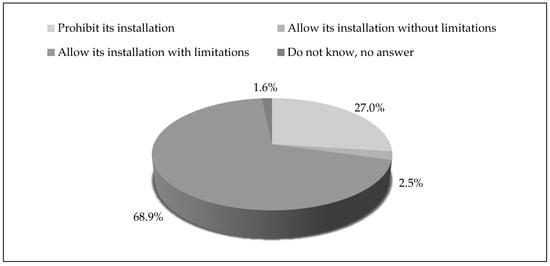
Figure 11.
Opinion on photovoltaic panels installations in the Alicante PDO.
In the event that the implementation of photovoltaic panel installations is allowed by the competent authority, there is a broad agreement to require the six limitations that have been proposed according to the following order of preference: the surface is to be occupied by the installation of photovoltaic panels (3.93), the visual protection of the installation by means of trees and/or bushes (3.92), the style of the necessary operational constructions (3.90), the needed earth movement to execute the installation (3.82), the distribution design of the photovoltaic panels on the surface (3.76), and the fencing of the installation (3.56) (Figure 12).
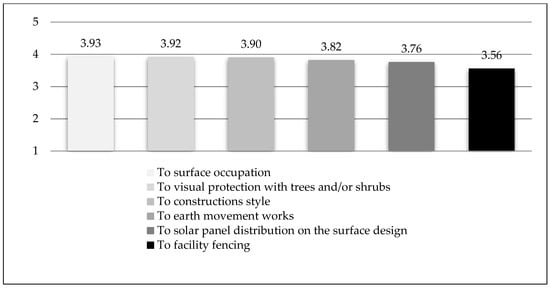
Figure 12.
Preferences on limitations to photovoltaic panels installations in Alicante PDO.
3.2.4. Opinion on limitations on Photovoltaic Installations
In the following section, limitations regarding the seven design characteristics are analyzed if the implementation of photovoltaic panel installations were allowed by the competent authority.
Regarding the limitation of the total area to be occupied, the most chosen option by almost half of the sample (43%) has been a maximum of 50 ha (equivalent to 100 soccer fields or 1 golf course), while the rest has not exceeded 10%. It should be noted that a third (32.8%) of the sample consider that they do not have enough criteria to answer (Figure 13).
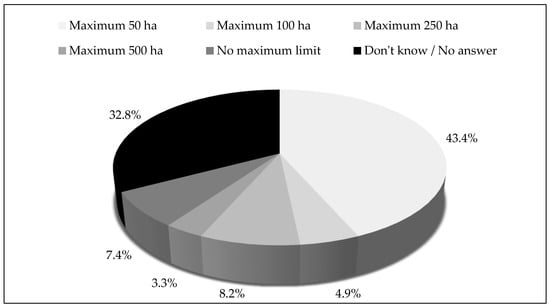
Figure 13.
Photovoltaic panel installations total area limitation.
Regarding the distribution of the solar panels in the total surface to be occupied, it was preferred to be dispersed within vineyards or environmental corridors (3.46), rather than the continuous and compact proposal (2.51) (Figure 14).
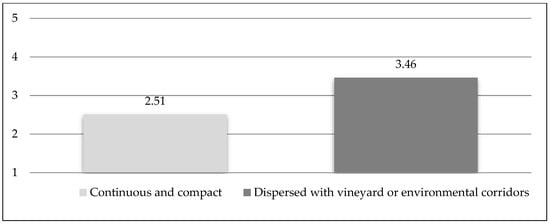
Figure 14.
Solar panels distribution design on surface.
Regarding the design of the evacuation lines for the electrical energy produced in the installation up to the network connection, the respondents preferred them to be underground (3.77), instead of aerial (2.51) (Figure 15).
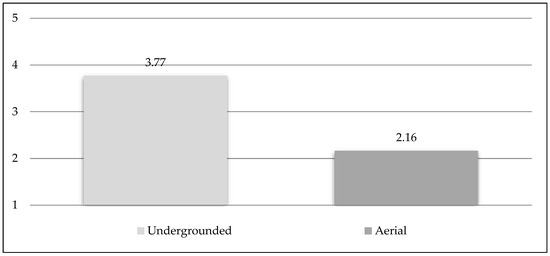
Figure 15.
Electrical energy evacuation lines location preference.
In relation to the style of the perimeter fencing, there is a clear preference towards natural fencing, either through groves with native species from the area, the most valued option (4.16), wooden or cane structures (3.87), and with hedges (3.52). Metal-type fences are not considered suitable, neither the cynegetic types (2.74) nor the simple torsion fences (2.13). There is neither rejection nor preference for leaving the installation without a fence (2.97), although that possibility is totally unaffordable for the owners of the photovoltaic panels due to easy exposure to thieves (Figure 16).
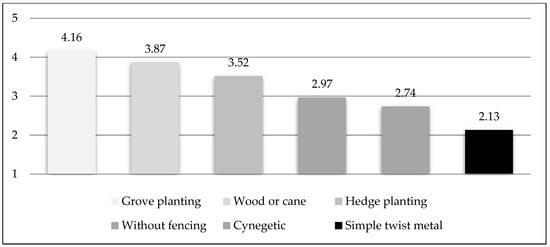
Figure 16.
Facility fencing style preferences.
With respect to the necessary earth movement for placing the installation, the most supported option is not to allow a great movement and adapt the installation to the profile of the terrain (3.93) rather than allowing as much movement as needed to maximize the efficiency of the solar panels (2.18) (Figure 17).
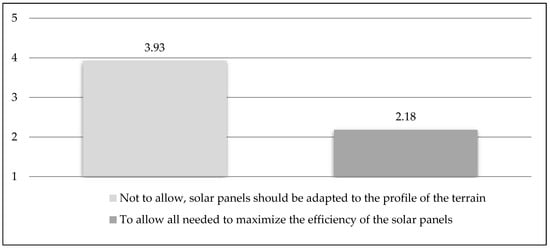
Figure 17.
Facility fencing style preferences.
Finally, considering the design of operational buildings, there is an important consensus that construction styles should be adapted to the rural architecture of the area (4.28) rather than permitting simple buildings without a special finish (2.12) (Figure 18).
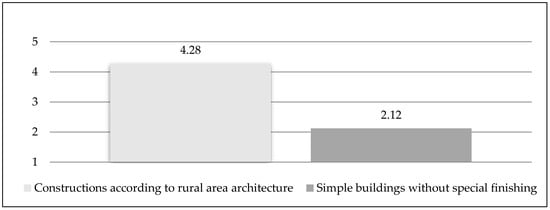
Figure 18.
Operational building style preferences.
3.3. Differences among Population Groups Segmented by Gender, Age, Education Level, Relationship with Wine Sector
To evaluate the influence of gender, age, educational level, and relationship with the wine sector on the assessments and opinions given by the surveyed, the sample was segmented into five groups. Table 7, Table 8, Table 9 and Table 10 show statistically significant results on differences among groups.

Table 7.
Gender segmentation results.

Table 8.
Age segmentation results.

Table 9.
Educational level segmentation results.

Table 10.
Relationship with the wine sector segmentation results.
Starting with gender segmentation, only four items show statistically significant differences (Table 7). Concerning the assessment of the photovoltaic panel installation landscape quality, the male group consider it worse (2.23 vs. 2.75). Related to the limitation of the total area occupied by solar panels, the male group is more favorable to employ them on the surface up to 50 and 100 ha (49.1% vs. 39.2% and 8.1% vs. 1.8%). The female group is more favorable to use 100 and 250 ha (12.5% vs. 4.9% and 3.6% vs. 3.3%). It is important to note that almost twice as many females (41.1%) did not answer the question, compared to males (23.1%). And also notice that 11.5% of the male group does not impose surface limitations, which is six times more female group rate (1.8%).
Following age segmentation results, a statistically significant difference is observed in only three questions. They are listed as follows in the order from highest to lowest support: young, adult, and senior (Table 8). The young group prefers more aerial evacuation lines that the others (2.69 vs. 2.06 vs. 1.17), without fencing the installation (2.69 vs. 2.06 vs. 1.17), and with simple buildings without special finishing (2.38 vs. 2.33 vs. 1.38). These results show that young group has less interest in landscape aspects and respect for private property.
There is only one question related to educational level segmentation where statistically significant differences exist (Table 9). The group that did not go to university is more in agreement with limitations to photovoltaic panels’ surface occupation (4.00) than the group that went to university (3.71).
Lastly, it can be observed in Table 10 that the group related to the wine sector values the landscape quality of the vineyards and the rural architecture of the area more than those who have no relationship with the wine sector (4.03 vs. 3.5 and 4.51 vs. 4.02).
3.4. Factorial Analysis to Identify the Main Components of the Survey
In order to confirm that this multivariable analysis methodology is suitable for the ongoing investigation, first of all the data structure needs to be tested for factorial analysis adequacy by Bartlett’s test of sphericity and the Kaiser–Meyer–Olkin (KMO) measure of sampling adequacy. With a KMO index value over 0.70 and Bartlett’s below 0.001 (Table 11), factorial analysis is feasible [53].

Table 11.
KMO and Bartlett test results.
Factorial analysis run identifies five components or factors that explain the 65.31% of the variance (Table 12).

Table 12.
Total explained variance.
Factor 1 holds the maximum variance and doubles the others as shown in sedimentation graph (Figure 19). The rest of the components explain lower proportions of the variance and have no correlations among them.
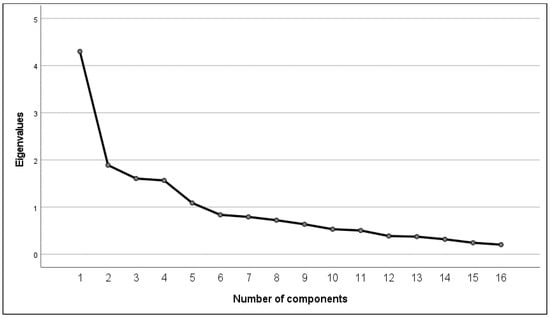
Figure 19.
Sedimentation graph.
Table 13 shows factorial analysis results among interdependent variables. Higher saturation values per variable are highlighted in different colors in the rotated component matrix.

Table 13.
Rotated component matrix.
According to the saturation values, Table 14 identifies the components or factors that underlay and briefly explain the survey. Component or Factor 1, the main one, epitomizes the most saturated questions related to limitations to photovoltaic installations, which are limitations to construction style, to solar panel distribution, to perimeter fencing, to surface occupation, to visual protection materials, and to earth movement works. Factor 2, with only two questions represented, clusters in accordance with the photovoltaic installations, entailing earth movement and simple twist metal fencing admissibleness. Factor 3 represents the PDO landscape quality, involving the two questions related to PDO landscape valuation. Factor 4 clusters preferences for the natural visual protection of the facility, focusing on grove planting and local grove planting. And lastly, Factor 5 signifies rural style, pooling predilections for natural wood or cane fencing and rural style for constructions.

Table 14.
Factors identification.
4. Discussion
Energy is the aspect that mainly contributes to climatic change, constituting 60% of total world greenhouse gas emissions [54].
Renewable energy generation is a worldwide priority scheduled in 2023 agendas. Objective 7, which aims to guarantee an affordable, safe, modern and sustainable energy access to citizens, is tightly linked to Objective 13, which urges pressing adoption measures to fight climate change and its effects. Both goals have important repercussions on other areas to boost prosperity. Several studies reveal positive and noteworthy effects on economic growth level of renewable energy sources [55].
World population growth tendency keeps increasing, as does the Spanish population with a 1.12% annual increase [56]. As a matter of fact, energy consumption demand is continuously growing, and so dependence on imported fossil fuels and its consumption increase, which negatively affects the environment and global warming process. In this situation, renewable energy production, such as solar, raises a realistic possibility to reduce dependence on fossil fuels [57] and to commit to the sustainable development goals.
Spain keeps fighting to untie economy growth from CO2 emissions. Solar energy benefits may bring an important reduction implementation, and therefore economic improvements, such as external dependence, balance of payments and, therefore, business and employment establishment.
In this line, Alicante province avoided 83,500 tons of CO2 in 2022 by turning to solar energy [58]. And within this context “agrivoltaic” systems run as alternatives for solar energy production on agricultural land with the best mutual utilization.
This approach is confirmed by the achieved results of this research, as the combination of vineyard cultivation with renewable energy generation through photovoltaic panels is the most socially accepted model. Nevertheless, the selected option has the following limitations, validated as main factor in the factorial analysis: a maximum occupation area of 50 hectares, maintaining the natural orography of the land and adapting the installation of the solar panels to the profile of the land; which follows a dispersed design with the presence of environmental corridors formed by vineyards, whose architectural elements are integrated as much as possible into the environment, including underground energy evacuation lines, rural-style auxiliary buildings, and a perimeter protection consisting of groves of the native species of the area, aiming to reduce the consequent visual impact. In this regard, the Paulownia Forest species may be subject to further analysis, due its many beneficial uses such as quality timber, enriched animal food, biomass, CO2 sinks, soil improvement, and slope retention with low irrigation and fertilization requirements [59].
In line with this model, technological initiatives have started to appear in Spain. Initiatives that allow the symbiotic coexistence of vineyards and solar panels, and that may play a positive role in the climatic peculiarities that affect the Alicante PDO vineyards, where the heat and lack of humidity lead to very quick ripening and depletion of the grapes, juice acidity reduction, and sugar level increase. Resulting in wines with higher alcohol content and less excellence and harmony, so early harvest is compulsory for optimal quality preservation. As a matter of fact, intelligent shading “agrivoltaic techniques” that may regulate sun incidence and the temperature on the vines would show relevance to achieving a progressive ripening of the grapes in the Alicante PDO in order to ensure the acidity and aromas of the wine, while generating renewable energy in the same land.
Although “agrivoltaic” systems have already been tested and developed in many countries over different crops, including grapes, with successful results so far even in India, where grape values have multiplied over 15 times to conventional grape production, while maintaining land use and enabling village electrification in rural areas [60]. There are only a few pilot experiences that are currently being tested in several Spanish regions. Such is the case of PowerfulTree, which is implementing its technology in 500 m2 of vineyards at Bodega San Gabriel in Ribera de Duero. Or the case of Iberdrola, where one of the biggest producers, distributor, and marketer companies in Spain, Winsolar, has launched its own photovoltaic project in the vineyards of González Byass and Grupo Emperador located in Guadamur (Toledo) [61]. These technological systems use sensors located in the vineyards to collect phenological and climatic parameters, such as solar radiation, soil moisture, or wind conditions [62]. In this way, the most exhaustive possible monitoring of the plant is pursued, aiming to improve the quality of the grapes and the use of the land, reducing irrigation water consumption and developing vineyards heat resistance.
Obviously, these initiatives are not exempt from controversy and disagreements. On one hand, there are supporters of using these techniques in less productive areas, or areas of low agricultural interest with unfavorable soil and climatic conditions, not seeming appropriate for the case of great agricultural value crops, such as vineyards. On the other hand, there are more conciliatory people with future vision, which would decidedly turn to “agrivoltaism”, preventing vines from being uprooted and favoring solar panel shading vine cultivation to satisfy crop needs [63] while producing green energy in the same plot, and so improving agricultural producers’ competitiveness. Studies confirm the beneficial interaction between agricultural and solar energy productions in the same area in terms of land-use efficiency, water use efficiency and photovoltaic panel efficiency [64]. Moreover, social investigations carried on with livestock and crop farmers, solar grazers and policy experts indicate, on one hand, the recognition of the potential benefits of “agrivoltaic” systems, and, on the other hand, affordability of the identified barriers by wise planning and mutually profitable land agreements [65].
According to this research, the social resolution to the existing dilemma related to PDO Alicante seems to trim towards a limited “agrivoltaism”, a combination of land use in vineyards subjected to limitations. That is the key component of the survey revealed by the factorial analysis.
5. Conclusions
To summarize the main findings of the survey, there is a broad consensus that quality of the wine-growing landscape and its associated cultural heritage in the territory of the Alicante PDO is greater than that of the photovoltaic panel plants. And so, a group of respondents (1/3 of the sample) is opposed to the implementation of any type of photovoltaic panel installations.
Despite this, the importance of solar energy generation for the environment is highly considered, and so 2/3 of the sample would allow photovoltaic panel plant installations in combination with vineyards in the same plot, and so accept “agrivoltaic” systems, but subject them to limitations on their use and design to maintain the wine-growing landscape as much as possible.
Segmentation analysis confirms that roles related to the wine sector value the vineyard landscape quality and the rural architecture of the area more, while the youngsters are concluded to be less interested in landscape aspects and respect for private property. Moreover, those surveyed who did not go to university are the most concerned about limitations to the photovoltaic panels surface occupation, with males preferring more restriction than females.
Limitations on photovoltaic installation are the main component of the research validated by factorial analysis. In the event that the implementation of photovoltaic panel installations is allowed by the competent authority, they should commit to the following design characteristics: occupy a maximum area of 50 ha, dispersed panel distribution with the vineyard or environmental corridors among them, undergrounded evacuation power lines, natural perimeter fences using native species groves, adaptation to the terrain profile as much as possible, and rural-style adapted operational buildings.
5.1. Policy Recommendation
In this backdrop of increasing sustainable dilemmas, in terms of policy recommendation, the results of this survey should make the competent administrations intend to reflect these requests for and when authorizing the installation of photovoltaic solar energy plants in territories covered by a wine PDOs and integrate policies to promote and favor “agrivoltaic” systems. Enhancing “agrivoltaism” would comply with the general demand of the population and would also support agricultural producers being competitive with their colleagues throughout Europe and the World.
5.2. Limitations and Future Directions and Limitations
As explained in the results section, the present research uses a quite limited sample in terms of participation and educational-level bias, due to the selected techniques to maximize time–cost conditions. Nevertheless, it constitutes a primary approach to a population view to identify the most socially accepted sustainable solar energy generation model for further investigations.
Furthermore, no economic information has been included to be valued, since the authors consider the cost–benefit analysis techniques to not be known by the general population. Therefore, a future direction of research would be carrying out a cost–benefit analysis of the different proposals to be evaluated by a group of experts using Delphi analysis methodology.
Author Contributions
All authors collaborated in all phases of the article. All authors have read and agreed to the published version of the manuscript.
Funding
This research received no external funding.
Data Availability Statement
Not applicable.
Acknowledgments
We are grateful to the professors at University Miguel Hernández and the representatives of social categories for their comments and useful suggestions that helped substantially in improving the questionnaire, and to all the anonymous population that completed the form to achieve the data for later analysis.
Conflicts of Interest
The authors declare no conflict of interest.
References
- Martínez, M.; Molinero, F. Landscape heritage value as quality image in Duero wine-producing territories. Cuad. Geográficos 2019, 58, 169–194. [Google Scholar] [CrossRef]
- Montella, M.M. Wine Tourism and Sustainability: A Review. Sustainability 2017, 9, 113. [Google Scholar] [CrossRef]
- Manfio, V. Landscape, tourism and wine in the Douro in Portugal: An imposing tradition. In Cadernos de Geografia; FLUC: Coimbra, Portugal, 2019; pp. 79–90. [Google Scholar] [CrossRef]
- Baraja, E.R.; de Celis, A.J.G.; Luque, D.H. Wine landscape management in Spanish Biosphere Reserves. Cuad. Geográficos 2019, 58, 145–168. [Google Scholar] [CrossRef]
- Assumma, V.; Bottero, M.; Ishizaka, A.; Tasiou, M. Group Analytic Hierarchy Process Sorting II Method: An Application to Evaluate the Economic Value of a Wine Region Landscape. Environ. Model. Assess. 2021, 26, 355–369. [Google Scholar] [CrossRef]
- Council of Europe. Council of Europe Landscape Convention 2020. Available online: https://www.coe.int/en/web/landscape/text-of-the-european-landscape-convention (accessed on 24 January 2023).
- Baraja, E.; Herrero, D. Wine landscape crisis and survival in Castilla León borders: Dynamics, strategies and appliances against abandonment and heritage value loss. Estud. Geográficos 2020, 81, e045. [Google Scholar] [CrossRef]
- Plaza, J.I.; Fernández, R. Wine landscape heritage value and its promotion in valleys and plains at East Zamora. Estud. Geográficos 2020, 81, e046. [Google Scholar] [CrossRef]
- Ortega, J. Territorial heritage: Territory as cultural and economic resource. Rev. Ciudad. 1998, 4, 33–48. [Google Scholar]
- Albert, K. Introducing historical landscape in the cultural heritage conservation through the example of the Tokaj wine region in Hungary. AUC Geogr. 2020, 55, 112–122. [Google Scholar] [CrossRef]
- Morales, F.J. Networks and tourism innovation processes in Murcia wine regions: Wine routes and its consequences on landscape transformation. Rev. Estud. Andal. 2012, 29, 83–104. [Google Scholar] [CrossRef]
- Fernández, J. Changes in industry and wine landscape in PDO Cigales (Castilla y León, Spain). Estud. Geográficos 2012, LXXIII, 63–90. [Google Scholar] [CrossRef][Green Version]
- Vlahos, G. Farming System Transformation Impacts on Landscape: A Case Study on Quality Wine Production in a Highly Contested Agricultural Landscape. Land 2020, 9, 120. [Google Scholar] [CrossRef]
- Settimini, E. Cultural Landscape and Living Heritage in the Vineyard Landscape of Langhe-Roero and Monferrato. Ph.D. Thesis, University of Leicester, Leicester, UK, June 2019. [Google Scholar]
- Renewable Energy Statistics. International Renewable Energy Agency (IRENA). 2023. Available online: https://www.irena.org/Publications/2023/Jul/Renewable-energy-statistics-2023 (accessed on 4 September 2023).
- Ašonja, A. Facilities with RES on Public Buildings in the City of Novi Sad. In Proceedings of the 13th International Scientific Conference MMA 2018 “Flexible Technologies”, Novi Sad, Serbia, 28–29 September 2018. [Google Scholar]
- Ašonja, A.; Vuković, V. The Potentials of Solar Energy in the Republic of Serbia: Current Situation, Possibilities and Barriers. Appl. Eng. Lett. 2018, 3, 90–97. [Google Scholar] [CrossRef]
- Jiwon, K.; Park, E.; Song, C.; Hong, M.; Jo, H.-W.; Lee, W.-K. How to manage land use conflict between ecosystem and sustainable energy for low carbon transition? Net present value analysis for ecosystem service and energy supply. Front. Environ. Sci. 2022, 10, 1044928. [Google Scholar] [CrossRef]
- Sancho, J.M.; Riesco, J.; Jiménez, C.; Sánchez de Cos, M.C.; Montero, J.; López, M. Solar Radiation Atlas of Spain using SAF Climate Data (EUMETSAT); Spanish Meteorological State Agency (AEMET); Ministry of Agriculture, Food and Environment: Madrid, Spain, 2012. [Google Scholar]
- Edification Technical Code (CTE). HE Basic Document. Climatic Zoning according to Diary Annual Average Global Solar Radiation. Ministry of Transports, Mobility and Urban Agenda: Spain, 14 June 2022. Available online: https://www.codigotecnico.org/pdf/Documentos/HE/DccHE.pdf (accessed on 6 September 2023).
- Global Solar Atlas. The World Bank Group. 2016. Available online: https://globalsolaratlas.info/download/spain (accessed on 5 September 2023).
- Generalitat Valenciana. Decree Law 14/2020. Measures to accelerate the implementation of facilities for the use of renewable energy due to the climate emergency and the need for urgent economic recovery. 7 August 2020. Available online: https://cindi.gva.es/es/novedades/-/asset_publisher/68mT7WMwvnKp/content/decreto-ley-14-2020-de-7-de-agosto-de-medidas-para-acelerar-la-implantacion-de-instalaciones-para-el-aprovechamiento-de-las-energias-renovables-por-la/161328209 (accessed on 10 July 2023).
- Ministry for the Ecological Transition and the Demographic Challenge. National Integrated Energy and Climate Plan (PNIEC 2021–2030). 2020. Available online: https://www.miteco.gob.es/images/es/pnieccompleto_tcm30-508410.pdf (accessed on 18 May 2023).
- Valero, M.A. Great Speculative Capital Looms over photovoltaic against Neighbours and Town Halls. El Salto Diario. 2022. Available online: https://www.elsaltodiario.com/energias-renovables/mercaderes-del-sol-el-gran-capital-especulativo-se-cierne-sobre-la-fotovoltaica-ante-la-desconfianza-de-vecinos-y-ayuntamientos/ (accessed on 18 November 2022).
- EPDV. PDO Alicante Collects Signatures to Protect Its Territory against Solar Plants. 2021. Available online: https://elperiodicodevillena.com/la-dop-alicante-recoge-firmas-para-proteger-el-territorio-frente-a-las-plantas-solares/ (accessed on 20 November 2022).
- PDO Alicante. Institucional Manifiesto “El Viñedo del Sol”. 2021. Available online: https://vinosalicantedop.org/wp-content/uploads/2021/06/DECLARACIÓN-el-viñedo-del-sol-integrado-1.pdf (accessed on 8 January 2023).
- Wine Landscape Preservation Catalogue Will Protect Special Value Areas. 2022. Available online: https://5barricas.valenciaplaza.com/el-futuro-catalogo-de-proteccion-de-los-paisajes-del-vino-permitira-mayor-visibilidad-del-sector-e-identificar-zonas-de-especial-valor/ (accessed on 5 November 2022).
- Territorial Politics Conselleria, Public Works and Mobility. Catalog for the Protection of Agricultural Cultural Landscapes of Wine in Valencia Community. 2022. Available online: https://politicaterritorial.gva.es/documents/20551069/355083696/Catálogo+de+Protección+de+los+Paisajes+Agrarios+Culturales+del+vino+de+Alicante.pdf/ca98345f-0a2c-17fb-5120-20cad89294cf?t=1645708378778 (accessed on 3 February 2023).
- Vozmediano, J.R. Solar Farms Expansion and Characteristics. NI, 2021. Available online: https://negocioinmo.com/expansion-y-caracteristicas-de-los-huertos-solares/ (accessed on 10 November 2022).
- van de Ven, D.J.; Cazcarro, I. Solar energy and bioenergetics effects in rural environment in decarbonisation sceneries of Spain for 2050. Papeles Energía 2020, 9, 85–132. [Google Scholar]
- Van de Ven, D.J.; Capellan-Peréz, I.; Arto, I.; Cazcarro, I.; de Castro, C.; Patel, P. The potential land requirements and related land use change emissions of solar energy. Sci. Rep. 2021, 11, 2907. [Google Scholar] [CrossRef] [PubMed]
- Tsoutsos, T.; Frantzeskaki, N.; Gekas, V. Environmental impacts from the solar energy technologies. Energy Police 2005, 33, 289–296. [Google Scholar] [CrossRef]
- Prăvălie, R.; Sirodoev, I.; Ruiz-Arias, J.; Dumitrascu, M. Using renewable (solar) energy as a sustainable management pathway of lands highly sensitive to degradation in Romania. A countrywide analysis based on exploring the geographical and technical solar potentials. Renew. Energy 2022, 193, 976–990. [Google Scholar] [CrossRef]
- Silva, L.; Sareen, S. Solar photovoltaic energy infrastructures, land use and sociocultural context in Portugal. Local Environ. 2021, 26, 347–363. [Google Scholar] [CrossRef]
- Goetzberger, A.; Zastrow, A. On the Coexistence of Solar-Energy Conversion and Plant Cultivation. Int. J. Sol. Energy 1982, 1, 55–69. [Google Scholar] [CrossRef]
- Hernandez, R.R.; Armstrong, A.; Burney, J.; Ryan, G.; Moore-O’Leary, K.; Diédhiou, I.; Grodsky, S.M.; Saul-Gershenz, L.; Davis, R.; Macknick, J.; et al. Techno–ecological synergies of solar energy for global sustainability. Nat. Sustain. 2019, 2, 560–568. [Google Scholar] [CrossRef]
- Valle, B.; Simonneau, T.; Sourd, F.; Pechier, P.; Hamard, P.; Frisson, T.; Ryckewaert, M.; Christophe, A. Increasing the total productivity of a land by combining mobile photovoltaic panels and food crops. Appl. Energy 2017, 206, 1495–1507. [Google Scholar] [CrossRef]
- Weselek, A.; Ehmann, A.; Zikeli, S.; Lewandowski, I.; Schindele, S.; Hogy, P. Agrophotovoltaic systems: Applications, challenges, and opportunities. A review. Agron. Sustain. Dev. 2019, 39, 35. [Google Scholar] [CrossRef]
- Dupraz, C.; Marrou, H.; Talbot, G.; Dufour, L.; Nogier, A.; Ferard, Y. Combining solar photovoltaic panels and food crops for optimising land use: Towards new agrivoltaic schemes. Renew. Energy 2011, 36, 2725–2732. [Google Scholar] [CrossRef]
- Mavani, D.D.; Chauhan, P.M.; Joshi, V. Beauty of Agrivoltaic System regarding double utilization of same piece of land for Generation of Electricity & Food Production. Glob. Sci. J. 2019, 10, 118–148. [Google Scholar]
- Zainol Abidin, M.A.; Mahyuddin, M.N.; Mohd Zainuri, M.A.A. Solar Photovoltaic Architecture and Agronomic Management in Agrivoltaic System: A Review. Sustainability 2021, 13, 7846. [Google Scholar] [CrossRef]
- Mignanelli, D.; Olaskoaga, I. Agrivoltaism: A new technology at vine-grower service. Castilla León Lands Agric. 2022, 307, 54–57. [Google Scholar]
- Wydra, K.; Vollmer, V.; Schmidt, S.; Prichta, S.; Kunze, R.; Aulich, H. Potential dercAgri-Photovoltaik in Thüringen; SolarImput 2022, Freistat Thüringen; Ministerium für Umwelt, Energie und Naturschutz: Erfurt, Germany, 2022. [Google Scholar]
- Perelló, S. Social Research Methodology; Dykinson: Madrid, Spain, 2009. [Google Scholar]
- Cochran, W.G. Sampling Techniques, 3rd ed.; John Wiley & Sons: New York, NY, USA, 1977. [Google Scholar]
- Nunnally, J.; Bernstein, L. Psychometric Theory; McGraw-Hill: Nueva York, NY, USA, 1994. [Google Scholar]
- R Core Team. R: A Language and Environment for Statistical Computing; R Foundation for Statistical Computing: Salzburg, Austria, 2013; Available online: https://www.R-project.org/ (accessed on 4 May 2023).
- López-Aguado, M.; Gutiérrez-Provecho, L. How to analyse and interpret an exploratory factorial analysis using SPSS. REIRE 2019, 12, 1–14. [Google Scholar] [CrossRef]
- Maronik, T. The role of the internet in survey research: Guidelines for researchers and experts. J. Glob. Bus. Technol. 2009, 5, 22. [Google Scholar]
- Couper, M.P. Web surveys, a review of issues and approaches. Public Opin. Q. 2000, 64, 464–494. [Google Scholar] [CrossRef]
- Flick, U. Triangulation revisited: Strategy of validation or alternative? J. Theory Soc. Behav. 1992, 22, 175–197. [Google Scholar] [CrossRef]
- Magnani, R.; Sabin, K.; Saidel, T.; Heckathorn, D. Review of sampling hard-to-reach and hidden populations for HIV surveillance. AIDS 2005, 19, 67–72. [Google Scholar] [CrossRef]
- Pérez, C. Multivariable Analysis Data Techniques; SPSS Applications; Pearson; Prentice Hall: Madrid, Spain, 2008. [Google Scholar]
- United Nations (UN). Agenda 2030. Sustainable Development Goals. Available online: https://www.un.org/sustainabledevelopment/es/development-agenda/ (accessed on 23 July 2023).
- Wang, G.; Sadiq, M.; Bashir, T.; Jain, V.; Ali, S.A.; Shabbir, M.S. The dynamic association between different strategies of renewable energy sources and sustainable economic growth under SDGs. Energy Strategy Rev. 2022, 42, 100886. [Google Scholar] [CrossRef]
- INE. National Statistics Institute. Population’ Continue Statistics. 1 July 2023. Available online: https://www.ine.es/dyngs/INEbase/es/operacion.htm?c=Estadistica_C&cid=1254736177095&menu=ultiDatos&idp=1254735572981#:~:text=Estad%C3%ADstica%20continua%20de%20poblaci%C3%B3n.,%C3%9Altimos%20datos&text=La%20poblaci%C3%B3n%20de%20Espa%C3%B1a%20aument%C3%B3,la%20colombiana%2C%20marroqu%C3%AD%20y%20espa%C3%B1ola (accessed on 10 August 2023).
- Blagojević, N.; Dihovicni, D.; Krunic, V. Analysis of a solar plant for the production of hot consumption water for the hospital. Adv. Eng. Lett. 2022, 1, 23–27. [Google Scholar] [CrossRef]
- UNEF. Ranking of Autonomous Communities That Mostly Avoided CO2 Emissions by the Substitution of Fossil Fuels for Solar Energy. Available online: https://www.unef.es/es/comunicacion/comunicacion-post/estas-son-las-10-comunidades-autonomas-que-mas-emisiones-de-co2-evitaron-gracias-al-caracter-de-sustitucion-de-combustibles-fosiles-de-la-energia-solar (accessed on 24 July 2023).
- Testa, R. Assessing the economic profitability of Paulownia as a biomass crop in Southern Mediterranean area. J. Clean. Prod. 2022, 336, 130426. [Google Scholar] [CrossRef]
- Malu, P.R.; Sharma, U.S.; Pearce, J.M. Agrivoltaic potential on grape farms in India. Sustain. Energy Technol. Assess. 2017, 23, 104–110. [Google Scholar] [CrossRef]
- López, N. Iberdrola Starts Up Winesolar, the First Smart Agrivoltaic Plant in Spain. 2022. Available online: https://www.energynews.es/iberdrola-pone-en-marcha-winesolar-la-primera-planta-agrovoltaica-inteligente-de-espana/ (accessed on 23 July 2023).
- M.A. The new agricultural revolution. 2022. Available online: https://elpais.com/sociedad/repensemos/2022-11-21/la-nueva-revolucion-agricola.html (accessed on 23 July 2023).
- Cano, L. Solar Panels to Improve Vineyards. 2022. Available online: https://www.larazon.es/medio-ambiente/20220121/4gmc7duh5jhzjirbtsg3kessaq.html (accessed on 23 July 2023).
- Proctor, K.W.; Murthy, G.S.; Higgins, C.W. Agrivoltaics align with green new deal goals while supporting investment in the US’ rural economy. Sustainability 2021, 13, 137. [Google Scholar] [CrossRef]
- Pascaris, A.S.; Schelly, C.; Pearce, J.M. A First Investigation of Agriculture Sector Perspectives on the Opportunities and Barriers for Agrivoltaics. Agronomy 2020, 10, 1885. [Google Scholar] [CrossRef]
Disclaimer/Publisher’s Note: The statements, opinions and data contained in all publications are solely those of the individual author(s) and contributor(s) and not of MDPI and/or the editor(s). MDPI and/or the editor(s) disclaim responsibility for any injury to people or property resulting from any ideas, methods, instructions or products referred to in the content. |
© 2023 by the authors. Licensee MDPI, Basel, Switzerland. This article is an open access article distributed under the terms and conditions of the Creative Commons Attribution (CC BY) license (https://creativecommons.org/licenses/by/4.0/).